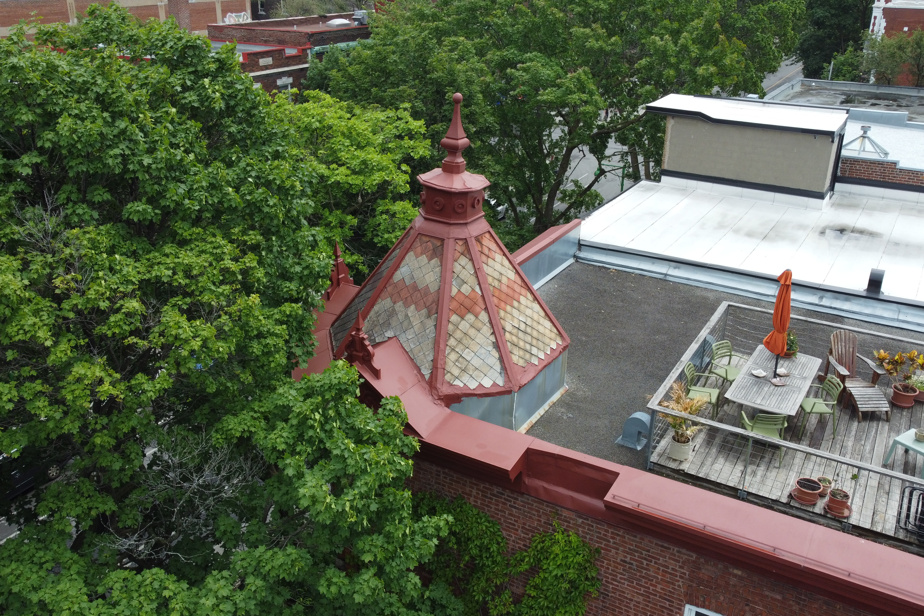Many flat roofs serve as head coverings without really visually covering residential buildings. What are their attractions and the architectural means to add character to this flat surface which can give the impression of an unfinished building? One thing is certain: they are less flat than you might think…
“The subject of roofs has preoccupied me since around 2015, when I obtained a major research grant from the French government to lead an international collective between Paris, Montreal and Chicago. The Roofscape collective looked into the question of the future of roofs,” explains researcher Alena Prochazka, responsible for practical training at the School of Architecture of the University of Montreal.
The main concern of the program was how to build with energy efficiency in mind. Several criteria were taken into account, including densification by expanding in height and the possibility of offering extensions to residents between the interior and exterior by making roof terraces.

PHOTO MARCO CAMPANOZZI, THE PRESS
Alena Prochazka is responsible for practical training at the School of Architecture of the University of Montreal.
Currently in Montreal, Alena Prochazka has the impression of being in another city. “For half a century, all development was stagnant. For several years, things have been growing haphazardly, because there are no supervised projects as much as in Europe. »
There are only a handful of French and English-style steep-roofed heritage houses remaining in Montreal, which became a city of flat roofs in the early 20th century.e century. In the 1970s, we began to save the old; then, in the 1980s, urban planning rules were put in place for integration between the existing and the new, relying heavily on the neo-Victorian style of Montreal plexes, in particular with the crownings on the facade which give the the impression that the roof has a specific shape.
Three major reasons behind the flat roof in Montreal
1) its economic framework
2) it is cheaper to waterproof it, because its surface area is less than that of a pitched roof
3) it allows better management of rain and snow treatment
A “forgotten” territory
The flat roof is actually not really flat, since it includes slight slopes towards a central drain which directs excess water towards the sewers. Its design helps reduce heat islands, when it is white and accommodates a plant cover. In addition, it can accommodate a wind power system, solar panels and a living space. According to the conclusions of the research carried out by Roofscape, all the roofs of a city can convert the natural elements (rain, wind, plants, etc.) that they collect into useful resources to thus offer important ecosystem services.
Flat roofs in urban environments can cover up to 40% of a city’s footprint. The potential of this forgotten roof territory is therefore very important and could help us resolve environmental issues which are increasingly urgent.
Alena Prochazka, practical training manager at the School of Architecture of the University of Montreal
According to the researcher, the issue of roofs can really contribute to building cities differently.

PHOTO FRANÇOIS ROY, THE PRESS
This flat-roofed building, located on Bernard Avenue West, in Montreal, is decorated with architectural elements giving it relief.
Take care of aesthetics
In Montreal, Victorian houses that have a crowning can inspire the aesthetics of new constructions. New projects built on the island often have specific architectural treatment in this area, which is beneficial for intelligent integration with the existing structure. “Each era makes its architectural mark and builds differently, but the whole can be harmonious. The concern for integration without mimicry is essential to fit into a context, whether natural or urban,” explains M.me Prochazka.

PHOTO MARTIN CHAMBERLAND, LA PRESSE ARCHIVES
An example of ornaments and details to break up the cubic effect of the flat roof.
To this fundamental integration criterion is added that of proportions and attention to detail to break the sterile cubic effect of certain flat-roofed homes. “Roof overhangs, sometimes sloping, friezes, columns, interlocking pieces of wood, or ornaments around windows can be developed in order to bring a certain richness to flat roofs thanks to the details,” underlines André Casault, architect and professor in the faculty of planning, architecture, art and design at the School of Architecture of Laval University.

PHOTO PAUL DUSSAULT PROVIDED BY STUDIO SPACE AGENCY
This town house designed with densification in mind fits harmoniously into the Limoilou district. Created by the Agence Spatiale studio.
For places like Quebec, sloping roofs have an important heritage dimension because they contribute to the city’s signature identity. “In the past, we made sloping roofs because they were easier to seal than flat roofs, but today, there are effective membranes regardless of the type of roof,” explains André Casault. In Quebec, we have more snow than in Montreal and ice problems. You just have to be a little more vigilant when you have a flat roof when it comes to snow removal, especially in the event of a heavy snowfall followed by a mild spell. »
-

3D IMAGE PROVIDED BY STUDIO SPACE AGENCY
Large terraces bring both an aesthetic and utilitarian dimension to this flat-roofed house designed by the Agence Spatiale studio.
-

3D IMAGE PROVIDED BY STUDIO SPACE AGENCY
This project from the Agence Spatiale studio combines a two-sloped roof reminiscent of the farms in its region, Charlevoix, and a flat green roof.
1/2
Architect Étienne Bernier, from the Agence Spatiale studio, says he creates as many sloping roofs as flat roofs. He notes that, very often, for residences in nature, sloping roofs have more advantages, because they manage snow better and prevent water from running down the facades. “In urban contexts, such as central neighborhoods, flat roofs allow us to achieve greater height and have an additional habitable floor. That said, there is currently a strong trend towards a return to sloping roofs. » Some of its recent projects brilliantly combine flat and sloping roofs. Great food for thought.
